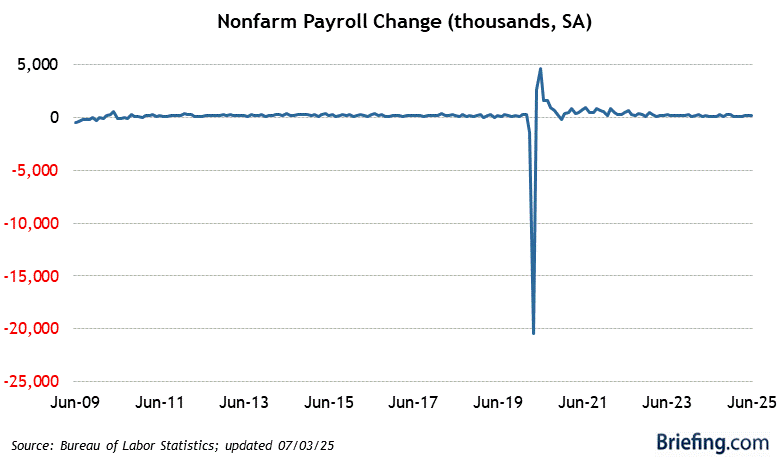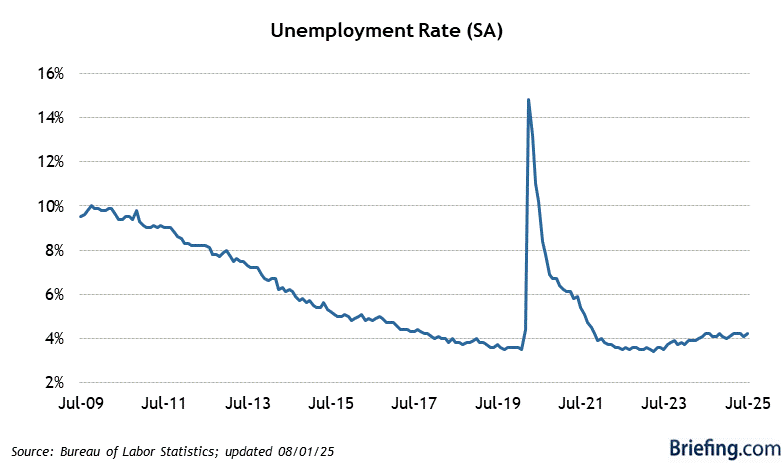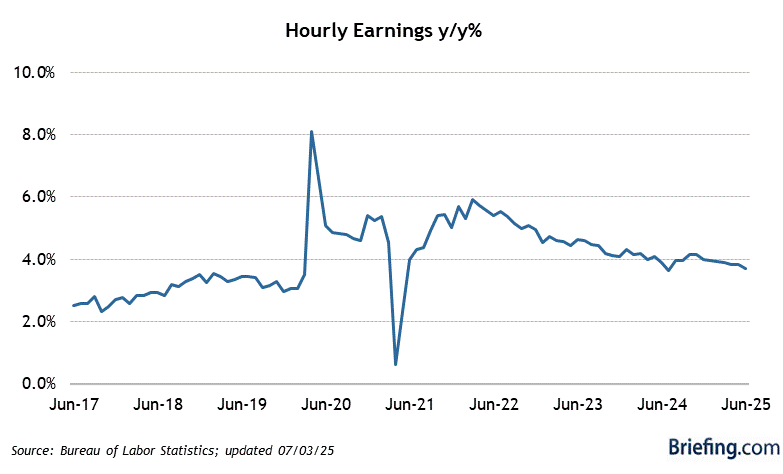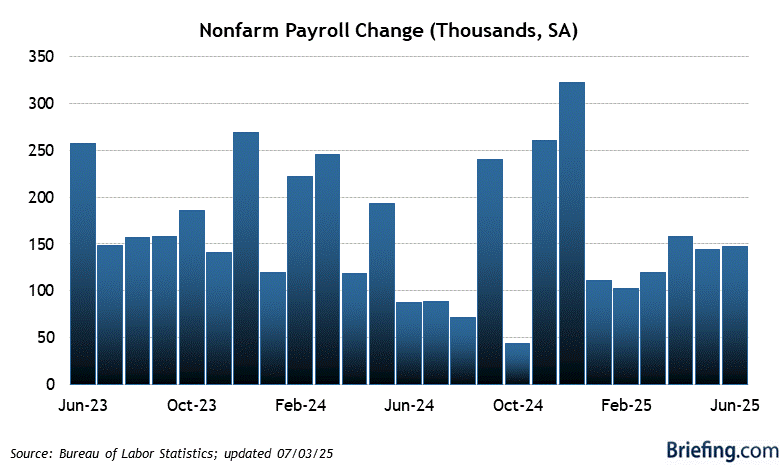



Highlights
- Total payrolls shrank by 131,000 in July after falling a negatively revised 221,000 in June. The Briefing.com consensus expected a payroll decline of -87,000.
- The private sector added 71,000 jobs in July, which was slightly less than the 83,000 expected by the consensus. June's private payrolls were revised down from 83,000 to 31,000 and were more in-line with the 13,000 predicted by last month's ADP report.
- The unemployment rate remained at 9.5%, but that figure is misleading. The rate only held steady because the labor force participation rate continued its downward move. The lack of steady labor force participation is a stark reminder that the unemployed are losing faith in the economic recovery.
- It is important to note that both hours worked and hourly earnings increased in July. The 0.5% weekly earnings growth will drive consumption higher and help offset the effects of the second consecutive month of triple-digit layoffs.
Key Factors
- The employment report from July revealed more of the same. Firms are still reluctant to increase their labor needs and the economic recovery remains in a sluggish - but upward moving - path.
- The drop in payrolls can be mostly attributed to 143,000 temporary census workers completing assignments. The rest of the government sector shed an additional 59,000 jobs, which was in-line with earlier reports of state and local government layoffs required by budgetary cuts.
- The details of the payroll data do reveal a stable service-providing sector and a slightly growing goods-producing sector. Manufacturing payrolls rose by 36,000 in July, almost three times as many workers as June. The construction industry lost another 11,000 jobs, but 10,000 of those were attributed to strike activity.
- If the number of workers in the labor force held at June's level, the unemployment rate would have risen to the consensus expectation of 9.6%.
Big Picture
- The 241,000 increase in April's private payrolls looks to be an outlier and the latest data confirms that we are stuck in a jobless recovery. At this point, the unemployment rate may not be the best indicator of labor strength as workers leaving the job market have artificially deflated the number. Instead, we should concentrate on private payroll growth. Once private payrolls stabilize above 100,000, we should start to see improvement in the labor sector.
| Category | JUL | JUN | MAY | APR | MAR |
|---|---|---|---|---|---|
| Establishment Survey | |||||
| Nonfarm Payrolls | -131K | -221K | 432K | 313K | 208K |
| Goods-Producing | 33K | -3K | 21K | 67K | 57K |
| Construction | -11K | -21K | -29K | 22K | 27K |
| Manufacturing | 36K | 13K | 39K | 38K | 19K |
| Service-Providing | 38K | 34K | 30K | 174K | 101K |
| Retail Trade | 7K | -21K | -9K | 14K | 23K |
| Financial | -17K | -12K | -9K | 2K | -19K |
| Business | -13K | 23K | 26K | 70K | 1K |
| Temporary help | -6K | 11K | 30K | 23K | 32K |
| Education/Health | 30K | 26K | 25K | 28K | 49K |
| Leisure/Hospitality | 6K | 21K | -15K | 36K | 23K |
| Government | -202K | -252K | 381K | 72K | 50K |
| Average Workweek | 34.2 | 34.1 | 34.2 | 34.1 | 34.0 |
| Production Workweek | 33.5 | 33.4 | 33.5 | 33.4 | 33.3 |
| Factory Overtime | 3.8 | 3.8 | 4.9 | 3.8 | 3.7 |
| Aggregate Hours Index | 0.3% | -0.2% | 0.3% | 0.4% | 0.3% |
| Avg Hourly Earnings | 0.2% | 0.0% | 0.2% | 0.1% | 0.0% |
| Household Survey | |||||
| Civilian Unemp. Rate | 9.5% | 9.5% | 9.7% | 9.9% | 9.7% |
| Civilian Labor Force | -181K | -652K | -322K | 805K | 398K |
| Civilian Employed | -159K | -301K | -35K | 550K | 264K |
| Civilian Unemployed | -24K | -350K | -287k | 255K | 134K |
Release Details
The Employment Report
- Importance (A-F): This release merits an A.
- Source: Bureau of Labor Statistics, U.S. Department of Labor.
- Release Time: First Friday of the month at 8:30 ET for the prior month
- Raw Data Available At: http://stats.bls.gov/news.release/empsit.toc.htm.
In Brief
The employment report is actually two separate reports which are the results of two separate surveys. The household survey is a survey of roughly 60,000 households. This survey produces the unemployment rate. The establishment survey is a survey of 375,000 businesses. This survey produces the nonfarm payrolls, average workweek, and average hourly earnings figures, to name a few. Both surveys cover the payroll period which includes the 12th of each month.The reports both measure employment levels, just from different angles. Due to the vastly different size of the survey samples (the establishment survey not only surveys more businesses, but each business employs many individuals), the measures of employment may differ markedly from month to month. The household survey is used only for the unemployment measure - the market focusses primarily on the more comprehensive establishment survey. Together, these two surveys make up the employment report, the most timely and broad indicator of economic activity released each month.
Total payrolls are broken down into sectors such as manufacturing, mining, construction, services, and government. The markets follows these components closely as indicators of the trends in sectors of the economy; the manufacturing sector is watched the most closely as it often leads the business cycle. The data also include breakdowns of hours worked, overtime, and average hourly earnings.
The average workweek (also known as hours worked) is important for two reasons. First, it is a critical determinant of such monthly indicators as industrial production and personal income. Second, it is considered a useful indicator of labor market conditions: a rising workweek early in the business cycle may be the first indication that employers are preparing to boost their payrolls, while late in the cycle a rising workweek may indicate that employers are having difficulty finding qualified applicants for open positions. Average earnings are closely followed as an indicator of potential inflation. Like the price of any good or service, the price of labor reacts to an overly accommodative monetary policy. If the price of labor is rising sharply, it may be an indication that too much money is chasing too few goods, or in this case employees.
In Depth
The employment report is really two reports - the household survey and the establishment survey. These two surveys contain a wealth of timely information which justify this report's status as the most important economic release of the month. This same wealth of information can nevertheless turn into a dearth of knowledge if it is not placed in the proper context.Household and Establishment Surveys
The household and establishment surveys differ due to the source of the data, as the names suggest. The household survey is a survey of households and the establishment survey is a surveys of businesses. The establishment survey, which is sometimes referred to as the payrolls survey, is favored by the market for a simple reason - it is far more comprehensive. Both surveys attempt to measure employment conditions at the roughly the same point in time - the household survey covers the calendar week which includes the 12th of the month while the establishment survey covers the pay period (be it a week, two weeks, or longer) which includes the 12th. But the establishment survey covers 390,000 businesses which employ 47 million people, while the household survey covers just 50,000 individuals. With a sample size which is 940 times larger than the household survey, it is hardly surprising that the market is more interested in the establishment survey.Aside from the sample size, the surveys differ in other significant ways. The household survey counts farm workers, the self-employed, unpaid family workers, and private household workers as employed; the establishment survey does not. The household survey can only count one individual as employed once, even if that person holds two jobs. The establishment survey will double count an individual who appears on the payrolls of two companies. There are other, less significant differences, but let's turn now to the statistics produced by the two surveys.
The Establishment Survey
Nonfarm Payrolls
Without question, the single most important piece of data contained in the employment report generally and the establishment survey specifically is nonfarm payrolls. As the name implies, nonfarm payrolls measure the number of people on the payrolls of all non-agricultural businesses. The monthly changes in payrolls can be quite volatile, occasionally varying by better than 200K from one month to the next. Even with this volatility and the possibility of large revisions to past data, the payrolls figures offer the most timely and comprehensive snapshot of the economy.Average Workweek
The workweek, also referred to as hours worked, is an often underrated indicator in the establishment survey. The average number of hours worked by employees on nonfarm payrolls is an important determinant of both industrial production and personal income in any given month. The workweek typically sees changes of a tenth or two each month, but can see much larger swings, such as the four tenth decline reported for October. To understand the importance of these changes in the workweek, note that a one tenth decline in the average workweek of 120 mln workers (roughly the current level of employment) results in 12 mln fewer hours worked. To create a similar decline in manhours through a change in employment, payrolls would have to fall 340K. For the purposes of production and income calculations, a one tenth of an hour change in the workweek is equivalent to a 340K change in employment. Needless to say, the workweek data are therefore critical in judging the overall strength or weakness of the employment report.Aggregate Hours Worked
The aggregate hours worked index simply brings together the two series we just noted. By calculating an index which looks at both employment and the workweek, we get a complete picture of the total hours worked each month. This indicator is seen as a monthly proxy for GDP. By definition, the quarterly change in the amount of goods produced is equal to the change in manhours plus the change in productivity. As productivity is somewhat predictable from quarter to quarter, the aggregate hours worked index provides a helpful monthly read on the overall economy.Average Hourly Earnings
The last indicator from the establishment survey which is worthy of close inspection is average hourly earnings, which is important for two reasons. Alongside total manhours, the average earnings figure gives us a good indication of personal income growth during the month. Second, the earnings figures are closely watched during periods of strong economic growth for evidence of increasing wage pressures. Such has certainly been the case over the past year, as the market's reaction to the employment data has often turned on the change in hourly earnings and its implications for the inflation outlook.The Household Survey
The Unemployment Rate
As we noted earlier, the household survey is not nearly as reliable as the establishment survey due to the small size of the survey sample. This survey nevertheless receives attention, primarily because it is responsible for the one figure which is guaranteed to lead the nightly news - the unemployment rate. The unemployment rate demands little explanation, though it is worth noting that the rate can occasionally sees significant monthly changes which are due to flukes in the data. The rate is simply the result of dividing the number of people unemployed (labor force less employed) by the number of people in the labor force.The problem is that the employment and labor force measures in the household survey are far more volatile than even nonfarm payrolls. The reason, of course, is the small survey sample size. It is therefore useful to look at the labor force and employment figures themselves to determine if changes in the unemployment rate are due to aberrant swings in one or both of these series.
Beyond the basics of tallying up the labor force and employment, the household survey breaks down these totals in every way imaginable - by gender, race, age, type of job, duration of unemployment, and on and on. These breakdowns seldom are of interest to the financial markets. Perhaps the only two exceptions are the discouraged worker and part-time worker measures.
No comments:
Post a Comment